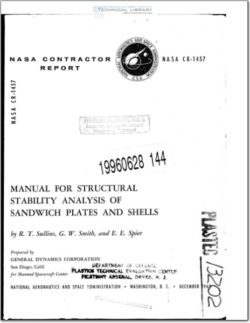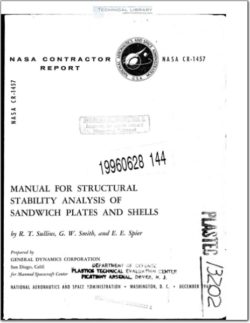NASA-CR-1457

- Version
- 1889 Downloads
- 11.46 MB File Size
- 1 File Count
- March 18, 2016 Create Date
- March 18, 2016 Last Updated
Manual for Structural Stability Analysis of Sandwich Panels

The basic objective of this study was to develop and compile a manual which
would include practical and up—to—date methods for analyzing the structural
stability of sandwich plates and shells for typical loading conditions which
might be encountered in aerospace applications> The methods proposed for
use would include known analytical approaches as modified for correlation
with applicable test data.
INTRODUCTION
1 . 1 GENERAL
This handbook presents practical methods for the structural stability analysis of
sandwich plates and shells. he configurations and loading conditions covered here
are those which are likely to be encountered in aerospace applications. Basic equa-
tions, design curves, and comparisons of theory against test data are included.
For the purposes of this handbook, a structural sandwich is defined as a layered
construction formed by bonding two thin facings to a comparatively thick core as
depicted in Figure 1. 1-1. The facings provide practically all of the over-all bending
and in—plane extensional rigidity to the sandwich. The core serves to position the
faces at locations removed from the neutral axis, provides virtually all of the trans— 1
verse shear rigidity of the sandwich, and stabilizes the facings against local buckling.
Thus the structural sandwich concept is quite similar to that of a conventional I
beam. Thesandwich core plays a role which is analogous to that of the I beam web
while the sandwich facings perform a function very much like that of the I beam
flanges. The primary difference between these two types of construction lies in the
Numbers in brackets
| File | Action |
|---|---|
| NASA-CR-1457 Manual for Structural Stability Analysis of Sandwich Panels.pdf | Download |

Comment On This Post